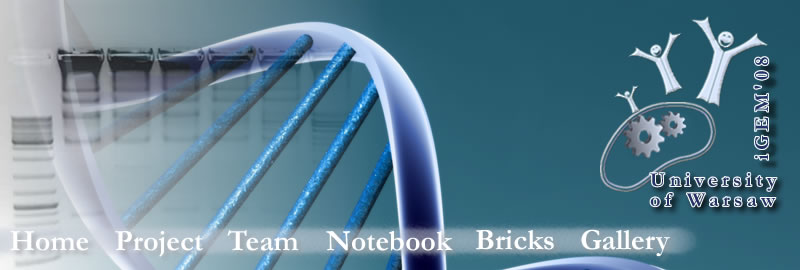Team:Warsaw/Calendar-Main/13 May 2008
From 2008.igem.org
(Difference between revisions)
MKrzyszton (Talk | contribs) |
|||
| Line 66: | Line 66: | ||
</p> | </p> | ||
| - | <img src="https://static.igem.org/mediawiki/2008/7/71/Aid_pcr_grad_WAW.jpg" width=350/><var>Fig. 1. Gradient PCR products for AID: 1-DNA ladder; 2 to 13-PCR products-border annealing temperatures of gradient: 62°C (lane 2) to 82°C (lane 13)</var> | + | <img src="https://static.igem.org/mediawiki/2008/7/71/Aid_pcr_grad_WAW.jpg" width=350/><var><b>Fig. 1.</b> Gradient PCR products for AID: 1-DNA ladder; 2 to 13-PCR products-border annealing temperatures of gradient: 62°C (lane 2) to 82°C (lane 13)</var> |
<img src="https://static.igem.org/mediawiki/2008/9/97/T7grad_WAW1.jpg" width=350/> | <img src="https://static.igem.org/mediawiki/2008/9/97/T7grad_WAW1.jpg" width=350/> | ||
| - | <var>Fig. 2. Gradient PCR products: upper - for transcriptional fusion, lower - for translation fusion; 1-DNA ladder; 2 to 12-PCR products-border annealing temperatures of gradient: 62°C (lane 2) to 82°C (lane 12)</var> | + | <var><b>Fig. 2.</b> Gradient PCR products: upper - for transcriptional fusion, lower - for translation fusion; 1-DNA ladder; 2 to 12-PCR products-border annealing temperatures of gradient: 62°C (lane 2) to 82°C (lane 12)</var> |
<img src="https://static.igem.org/mediawiki/2008/6/6c/T7grad_WAW2.jpg" width=350/> | <img src="https://static.igem.org/mediawiki/2008/6/6c/T7grad_WAW2.jpg" width=350/> | ||
| - | <var>Fig. 3. Gradient PCR products for negative control (Top10 genomic DNA): 1-DNA ladder; 2 to 6-PCR products-border annealing temperatures of gradient: 62°C (lane 2) to 82°C (lane 6).</var> | + | <var><b>Fig. 3.</b> Gradient PCR products for negative control (Top10 genomic DNA): 1-DNA ladder; 2 to 6-PCR products-border annealing temperatures of gradient: 62°C (lane 2) to 82°C (lane 6).</var> |
</html> | </html> | ||
Revision as of 15:27, 11 October 2008
 |
|||||||||
Preparation of pMPMT5+AID construct and PCRs for fusionsMichał K.
 Fig. 1. Gradient PCR products for AID: 1-DNA ladder; 2 to 13-PCR products-border annealing temperatures of gradient: 62°C (lane 2) to 82°C (lane 13) Fig. 1. Gradient PCR products for AID: 1-DNA ladder; 2 to 13-PCR products-border annealing temperatures of gradient: 62°C (lane 2) to 82°C (lane 13)
 Fig. 2. Gradient PCR products: upper - for transcriptional fusion, lower - for translation fusion; 1-DNA ladder; 2 to 12-PCR products-border annealing temperatures of gradient: 62°C (lane 2) to 82°C (lane 12)
Fig. 2. Gradient PCR products: upper - for transcriptional fusion, lower - for translation fusion; 1-DNA ladder; 2 to 12-PCR products-border annealing temperatures of gradient: 62°C (lane 2) to 82°C (lane 12)
 Fig. 3. Gradient PCR products for negative control (Top10 genomic DNA): 1-DNA ladder; 2 to 6-PCR products-border annealing temperatures of gradient: 62°C (lane 2) to 82°C (lane 6).
Fig. 3. Gradient PCR products for negative control (Top10 genomic DNA): 1-DNA ladder; 2 to 6-PCR products-border annealing temperatures of gradient: 62°C (lane 2) to 82°C (lane 6).
|
 "
"





